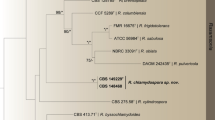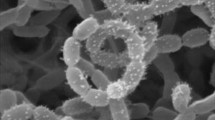Abstract
A morphological and physiological description of an anamorphic basidiomycetous yeast species isolated from soil, named Trichosporon wieringae, is presented. The phylogenetic position within the genus, based on nuclear base sequencing of the D1/D2 region of the large subunit of rDNA and of the ITS region reveals close relationship to the Porosum clade of the genus Trichosporon Behrend, T. gamsii being the closest relative. The ability of non-pathogenic Trichosporon species to assimilate uric acid, ethylamine, l-4-hydroxyproline, some aromatic compounds and polysaccharides as sole sources of carbon and energy was studied. An identification key to these species, based on growth tests on these non-conventional carbon sources, is proposed. The type strain of T. wieringae is CBS 8903 (JCM 12201).
Similar content being viewed by others
References
Barnett J.A., Payne R.W. and Yarrow D. 2000. Yeasts, Characteristics and Identification. 3rd Ed. Cambridge University Press, Cambridge, England, pp. 751–770.
Fell J.W, Boekhout T. and Freshwater D.W. 1995. The role ofnucleotide analysis in the systematics of the yeast genera Cryp-tococcusand Rhodotorula. Stud. Mycol. 38: 129–146.
Fell J.W., Boekhout T., Fonseca A., Scorzetti G. and Statzell-Tall-manA. 2000. Biodiversity and systematics of basidiomycetousyeasts as determined by large subunit rDNA D1D2 domain se-quenceanalysis. Int. J. Syst. Evol. Microbiol. 50: 1351–1371.
Fell J.W. and Scorzetti G. 2004. Reassignment of the basidiomyc-etousyeasts Trichosporon pullulans to Guehomyces pullulansgen. nov., comb.nov. and Hyalodendron lignicola to Trichos-poronlignicola comb.nov. Int. J. Syst. Evol. Microbiol. In press.
Guého E., Smith M.Th., de Hoog G.S., Billon-Grand G., Christen R., Batenburg-van der Vegte W.H. 1992. Contributions to a re-vision of the genus Trichosporon. Antonie van Leeuwenhoek 61: 289–316.
Guého E., Smith M.Th and de Hoog G.S. 1998. Trichosporon Be-hrend. In: Kurtzman C.L. and Fell J.W. (eds), The Yeasts, a taxonomic study4th. Ed. Elsevier Science B.V., Amsterdam, TheNetherlands, pp. 854–872.
de Hoog G.S., Guarro J., Gené. J. and Figueiras M.J. 2000. Atlasof Clinical Fungi. Centraalbureau voor Schimmelcultures, Utrecht, The Netherlands.
Kwon-Chung K.J. and Bennett J.W. 1992. Medical Mycology. Lea and Febiger, Philadelphia, USA.
Middelhoven W.J. 1993. Catabolism of benzene compounds by as-comycetousand basidiomycetous yeasts and yeastlike fungi. Aliterature review and an experimental approach. Antonie vanLeeuwenhoek 63: 125–144.
Middelhoven W.J. 1997. Assimilation of organic acids: the pH asdetermining factor. YEAST, a Newsletter for Persons Interested in Yeast 46: 19–20.
Middelhoven W.J. 2003. Identification of clinically relevantTrichosporon species. Mycoses 46: 7–11.
Middelhoven W.J., de Jong I.M. and de Winter M. 1991. Arxulaadeninivorans, a yeast assimilating many nitrogenous and aro-maticcompounds. Antonie van Leeuwenhoek 59: 129–137.
Middelhoven W.J., Scorzetti G. and Fell J.W. 1999. Trichosporonguehoae sp.nov., an anamorphic basidiomycetous yeast. Can. J.Microbiol. 45: 686–690.
Middelhoven W.J., Scorzetti G. and Fell J.W. 2000. Trichosporonveenhuisii sp.nov., an alkane-assimilating anamorphic basidio-mycetousyeast. Int. J. Syst. Evol. Microbiol. 50: 381–387.
Middelhoven W.J., Scorzetti G. and Fell J.W. 2001. Trichosporonporosum comb.nov., an anamorphic basidiomycetous yeastinhabiting soil, related to the loubieri/laibachii group of speciesthat assimilate hemicelluloses and phenolic compounds. FEMS Yeast Research 1: 15–22.
Middelhoven W.J. and Kurtzman C.P. 2003. Relation betweenphylogeny and physiology in some ascomycetous yeasts. Antonie van Leeuwenhoek 83: 69–74.
Middelhoven W.J., Scorzetti G. and Fell J.W. 2004. Systematics ofthe anamorphic basidiomycetous yeast genus Trichosporon Be-hrendwith the description of five novel species. viz. Trichos-poronvadense, T. smithiae, T. dehoogii, T. scarabaeorum and T. aigamsii. Int. J. Syst. Evol. Microbiol. In press.
Scorzetti G., Fell J.W., Fonseca A. and Statzell-Tallman A. 2002. Systematics of basidiomycetous yeasts: a comparison of largesubunit D1/D2 and internal transcribed spacer rDNA regions. FEMS Yeast Research 2: 495–517.
Sugita T. and Nakase T. 1998. Molecular phylogenetic study of thebasidiomycetous anamorphic yeast genus Trichosporon and re-latedtaxa based on small subunit ribosomal DNA sequences. Mycoscience 39: 7–13.
Sugita T., Nishikawa A. and Shinoda T. 1994. Reclassification of Trichosporon cutaneum by DNA relatedness, by the spectropho-tometricmethod and the chemoluminometric method. J. genappl. Microbiol. 40: 397–408.
Sugita T., Nishikawa A., Ikeda R. and Shinoda T. 1999. Identifica-tionof medically relevant Trichosporon species based onsequences of internal transcribed spacer regions and constructionof a database for Trichosporon identification. J. Clin. Microbiol. 37: 1985–1993.
Wieringa K.T. 1956. The micro-organisms decomposing pecticsubstances in the dew retting process of flax. Neth. J. Agric. Sci. 4: 204–209.
Yarrow D. 1998. Methods for isolation, maintenance, classificationof yeasts. In: Kurtzman C.L. and Fell J.W. (eds), The Yeasts, ataxonomic study 4th. Ed. Elsevier Science B.V., Amsterdam, TheNetherlands, pp. 77–100.
Author information
Authors and Affiliations
Rights and permissions
About this article
Cite this article
Middelhoven, W.J. Trichosporon wieringae sp.nov., an anamorphic basidiomycetous yeast from soil, and assimilation of some phenolic compounds, polysaccharides and other non-conventional carbon sources by saprophytic Trichosporon species. Antonie Van Leeuwenhoek 86, 329–337 (2004). https://doi.org/10.1007/s10482-004-0226-6
Issue Date:
DOI: https://doi.org/10.1007/s10482-004-0226-6




